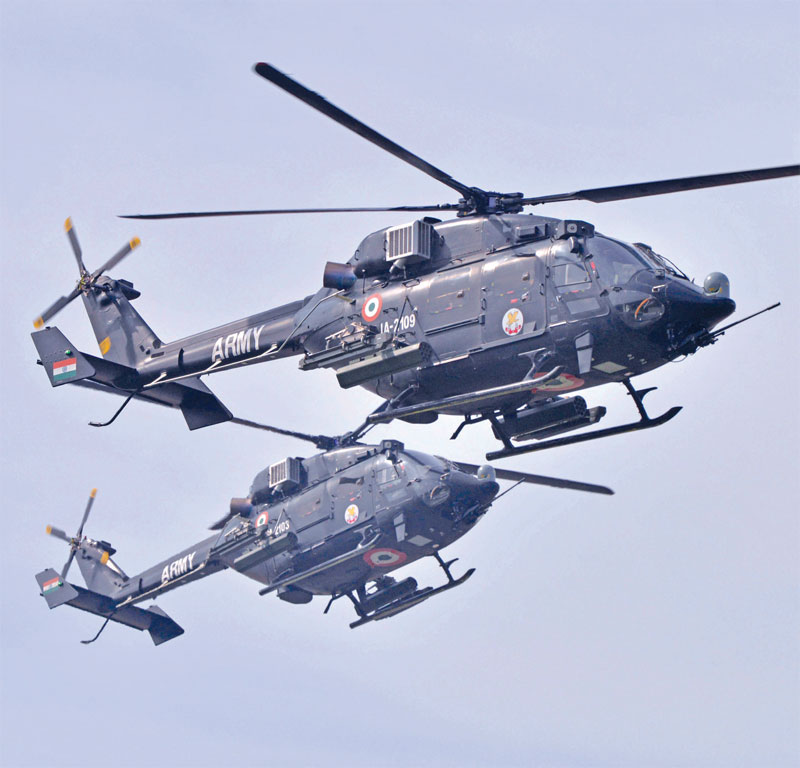The Jinx Continues
 Lt Gen. B.S. Pawar (retd)
Lt Gen. B.S. Pawar (retd)
Let me start on a positive note before I bring out the reality of the dismal state of the Indian military helicopter fleet. The induction of 22 AH-64E state of art Apache attack helicopters and 15 CH-47F Chinook multi-mission heavy lift helicopters, both the most modern and best in their respective categories in the world, into the Indian Air Force in the last two years, will no doubt enhance the operational capabilities of the Indian military but only to a limited extent.
These numbers are miniscule compared to our adversary in the north and will need to be augmented further, even though additional six Apache are expected to be inducted into the army in the next two to three years. More importantly, the Apache are heavy duty attack helicopters and cannot operate at high altitudes like the terrain we have in eastern Ladakh, the site of the current standoff with China, despite the optics of showing an Apache flying at Leh airfield sometime back, which was widely broadcasted by both our print and TV media. The reality is that the Apache are most suited for supporting mechanised operations and are ideal for Strike Corps operations in the plains and deserts.
The Chinooks, on the other hand, can operate at these altitudes and are already being employed in eastern Ladakh. In addition, the induction of almost 200 Mi-17V5 medium lift helicopters into the IAF in the last decade has been a very significant development in the helicopter capability enhancement, though they are basically replacing the old and obsolete fleet of Mi-8 helicopters held in the inventory. The Mi-17V5 is the more powerful version of the Mi-17 class of helicopters that entered service in the 1980’s and has better avionics, night capability and armament. The Mi-17V5 along with the existing Mi-17 fleet constitute a major medium lift capability that the Indian military can boast of today. As a matter of interest, the Mi-17V5 are currently also being used for VVIP duties.

ALH Rudra
The icing on the cake has been the approval for induction of 24 multi-role MH-60 ‘Romeo’ Seahawk helicopters from the US for the Indian Navy, which presently has 80 per cent of its ships/ frigates without the critical element of onboard helicopters for anti-submarine, anti-surface and search and rescue operations. The MH-60R is a formidable anti-submarine hunter-killer and will replace the ageing and the obsolete fleet of Sea King helicopters. These 24 helicopters will be inducted over a period of next two years.
The requirement of the navy is of course for many more (100 plus) helicopters of this class, but a beginning has been made and these helicopters along with the P8Is already acquired and the two Sea Guardian Drones acquired from the US on lease will greatly enhance the reach and capability of the Indian Navy in the IOR and even beyond to the Indo-Pacific, especially in view of the growing interest displayed by China in IOR. The above listed acquisitions, though significant indeed, are too few in numbers and relate only to a limited segment of the military helicopter inventory, basically the lift/ logistics and attack.
SOS to the MoD
The major issue being faced by the armed forces is the non-replacement of the ageing and virtually obsolete Cheetah/ Chetak fleet of light observation and surveillance helicopters which are reaching the end of their Total Technical Life by the end of next year. France, the country of original equipment manufacturer of Aloutte-II & III (Cheetah & Chetak in India) already
Subscribe To Force
Fuel Fearless Journalism with Your Yearly Subscription
SUBSCRIBE NOW
We don’t tell you how to do your job…
But we put the environment in which you do your job in perspective, so that when you step out you do so with the complete picture.







